For each language, an annotated consonant chart illustrates the evolution of the consonant system from Proto-Algonquian. In the consonant charts, solid arrows represent mergers or shifts, dotted arrows represent partial mergers or shifts, greyed-out characters represent Proto-Algonquian phonemes that no longer exist in the language, and characters prefixed by a plus sign represent new phonemes.
Each consonant chart is followed by expository notes; the charts themselves are based on the sources cited in these notes.
Note: I compiled this material and created the consonant charts during my PhD studies in 2011, and there are aspects of the content and presentation that could likely be improved.
Contents
- Proto-Algonquian
- Central languages: Meskwaki, Miami-Illinois, Shawnee, Menominee, Ojibwe, Cree
- Eastern languages: Proto-Eastern Algonquian, Mi'kmaq, Western Abenaki, Massachusett, Quiripi, Munsee Delaware, Nanticoke
- Plains languages: Cheyenne, Proto-Arapaho-Gros Ventre, Arapaho, Gros Ventre, Nawathinehena, Blackfoot
Proto-Algonquian
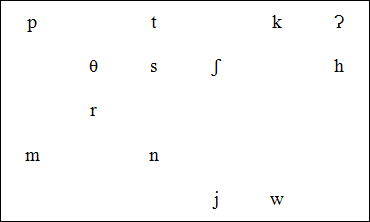
- *ʔ occurs only as the first (coda) element of a cluster. It arose from any underlying plosive (*p, *t, *k) (Pentland 1979).
- *θ has been proposed to be [ɬ] (Picard 1984, 1994) or [ɾ̥] (Pentland 1979).
- *r is Bloomfield's *l (following Goddard 1994); Pentland (1979) suggests [ɾ].
- Goddard (1994) proposes that *l was [r] [probably a flap?] and *θ was [θ]; he rejects the suggestion that *l and *θ differed only in voicing (as in Picard's l-ɬ and Pentland's ɾ-ɾ̥), because *θ underwent palatalization in PA and *l did not, which "strongly suggests" that *l, *θ "differed in some feature in addition to voicing" (204-5).
Palatalization:
- *t → *tʃ / __ i, iː, j
- *θ → *ʃ / __ i, iː, j
- *tʃ is a fully predictable alternant of *t, although it becomes a separate phoneme in all of the daughter languages.
- *ʃ also existed as a separate phoneme.
Central languages
Meskwaki

Notes from Bloomfield 1946:
- Merger: *θ, *r, *n > /n/
- *ʔ was only in clusters; it merged with *h before a stop and was lost before a fricative.
Miami-Illinois
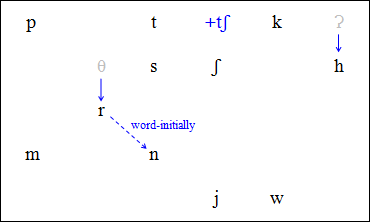
Notes from Costa 1991:
- *θ, *r fall together, merging with /n/ word-initially and becoming /r/ elsewhere (in the earliest records; became /l/ in modern dialects).
- Attested alternate pronunciation of /s/ as [θ] (regardless of the historical origin or preaspiration of /s/).
- Some words have /ʃ/ for expected /s/, mostly before /i/, especially /iV/.
- /m/ + short vowel can be deleted word-initially before preaspirated consonants or sibilants.
Shawnee
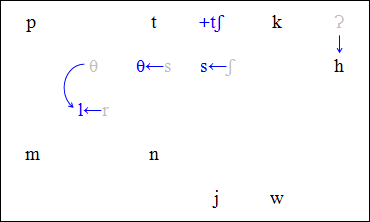
Notes from Pentland 1979:
- Split: *t > /t/, /tʃ/
- Merger: *θ, *r > /l/
- *ʔ (only found in clusters) > /h/ (phonetically [ʔ] in clusters, [h] or [ʔh] on its own)
- Chain shift: *s > /θ/; *ʃ > /s/. A fairly recent shift; a word list from 1755 still shows the original values.
- Phonetic process: /k/ is [k̯] before /i(ː)/ and [kʲ] before /e(ː)/ (Pentland 1979: 136).
Menominee

- /ʔ/ phoneme is from clusters only in the native vocabulary, but also occurs intervocalically in loans, "presumably from Ojibwa" (Pentland 1979: 358).
- /j, w/ came into contrast with /i, u/, unlike in PA (Miner 1979).
- Merger: *θ, *r, *n > /n/
- Merger: *s, *ʃ > /s/
- Neutralization: /p, k/ → /ʔ/ / __ C, as in PA; remains a synchronic rule only in Menomini (Pentland 1979: 376).
Ojibwe
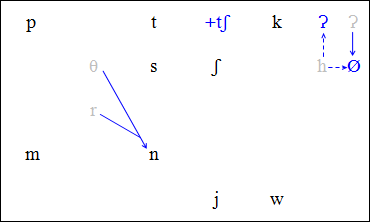
Notes from Bloomfield 1946:
- Merger: *θ, *r, *n > /n/
- Loss: *h and *ʔ lost in clusters (*hC, *ʔC > CC); *ʔ only occurred in clusters and so was completely lost.
- Phonetic change: *h > ʔ (when a single consonant), thus creating a new /ʔ/
Cree

Mergers (Pentland 1979):
- *θ, *t > /t/
- Plains, Woods, Western Swampy: *ʃ, *s > /s/
- Plains: *r, *j > /j/
- Swampy: *r, *n > /n/
- *ʔ was only in clusters; merged with *h, *s, *ʃ
Split (Pentland 1979):
- *t > /t/, /tʃ/
Phonetic change (Pentland 1979):
- Woods: *r > /ð/
- Moose: *r > /l/
Exception (Pentland 1979):
- In inflectional suffixes, *r > /h/ (and *nr > /h/) if *r is the last consonant in the word.
Eastern languages
Proto-Eastern Algonquian
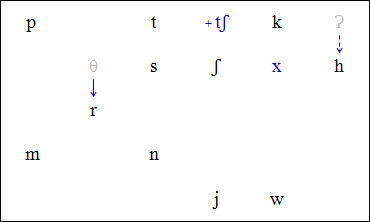
Notes from Goddard 1980:
- *θ, *r merge as */r/ except in clusters. Siebert (1975) says that they are kept separate in Powhatan, but Goddard disputes this.
- */r/ was probably "some sort of lateral flap" which has been replaced in many of the daughter languages "by a more European l copied from English or French" (Goddard 1978: 76).
- In clusters, *θ, *r become either */r/ or */x/, the latter being a new phoneme only found in such clusters. Goddard postulates the value /x/ based on Delaware.
- *ʔ (only found in clusters) > */h/ generally, */s/ before peripheral consonants (*p, *k).
Mi'kmaq
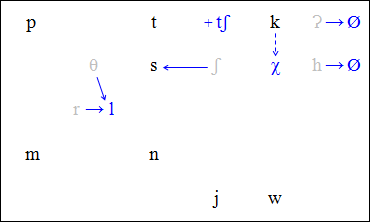
Notes from Hewson 1973 (Newfoundland Mi'kmaq):
- *ʃ merges with *s as /s/; *θ and *r merge as /l/.
- Hewson does not explicitly say so, but *h appears to be lost. *ʔ was found only in clusters, where it has been lost.
- /χ/ (Hewson's "q") is a post-velar fricative. Original rule: *k → [χ] before and after *a(ː), before *wa(ː), and after original *eː if subject to umlauting to /o(ː)/. This conditioning has been obscured (e.g. by *a > /ə/) and /χ/ now sometimes contrasts with /k/.
- Initial *#k did not become /χ/ by the preceding rule. Cases of initial #/χ/ in Mi'kmaq result from initial syllable loss.
Western Abenaki
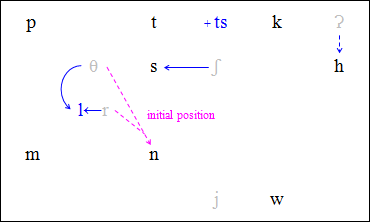
Notes from Warne 1975:
- *ʔ was found only in clusters and mostly falls together with *h in clusters (see cluster charts for details).
- *ʃ merges with *s.
- *θ, *r merge as /l/, which merges with /n/ in initial position.
- /ts/ is an alveo-dental affricate.
- *j is vocalized to /i/.
- Sonorant loss: sometimes *j, *h, *n, *l were lost intervocalically.
- Synchronic rules fed by /ə/-syncope: nasals are devoiced before a voiceless consonant; /p/ becomes /m/ before /m/; /pp, tt, kk/ behave like inherited /pp, tt, kk/ in that they can be preaspirated.
- Synchronic deletion: /h/ can delete intervocalically, except in careful spech; alternatively, /a/ can delete before /h/ (so /ahV/ → /aV/ or /hV/).
Massachusett
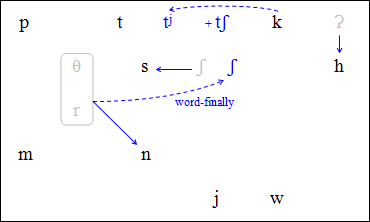
Notes from Goddard 1981:
- *ʃ merges with /s/. Massachusett /ʃ/ is a new phoneme, from word-final PEA *r and PEA *hx, *hr (from PA *-θ/*-r clusters).
- Elsewhere, PEA *r (from PA *θ, *r) merges with /n/.
- The old PA *θ → *ʃ mutation is continued in Massachusett by /n/ → /s/.
- Palatalization of /k/ created the new phoneme /tʲ/ before PEA *eː, *əw, and Pre-Massachusett weakened *iː followed by /m, (h)p, (h)k/. "Weakened *iː" is an *iː that would later merge with Massachusett /ə/ (PA *e); like all PEA *iː, it could theoretically come from PA *i or *iː, but by historical coincidence, all cases of palatalization-triggering PEA *iː come from PA short *i. Goddard (1981, 1990) argues at length that this really is a coincidence (arising from the distribution of *i/*iː in PA and the environment of weakening in Pre-Massachusett), and we do not need to posit an i-iː contrast in PEA.
- Presumably the environment for palatalization became opaque when (1) *eː became /aː/ and (2) weakened *iː merged with /ə/.
- *j was not a palatalization trigger because post-consonantal *j was lost in PEA.
- Consonant classes: weakened *iː followed by /m, (h)p, (h)k/ triggered palatalization; weakened *iː followed by /n, (h)t, h/ triggered infection (see vowel section for details).
Quiripi
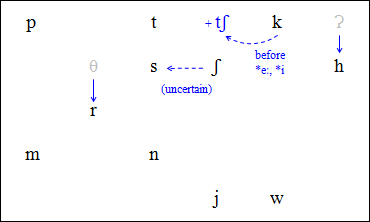
Notes from Rudes 1997:
- *θ, *r merge as */r/ except in clusters.
- *ʔ was only found in clusters; *ʔC clusters fall together with *hC clusters.
- *k palatalized to /tʃ/ before *i, eː (and also before *iː if Goddard 1981 is correct).
- Cannot tell whether *ʃ has merged with /s/ as in other Southern New England languages; Rudes seems inclined to think that it has. However, the mainland dialect appears to have a (new?) /ʃ/-/s/ contrast in reflexes of *-θ/*-r clusters (> /hʃ/) versus *hs, *hʃ (> /hs/); the mainland dialect also has word-final /ʃ/ from Pre-Quiripi *r# (insular has /s/).
Munsee Delaware
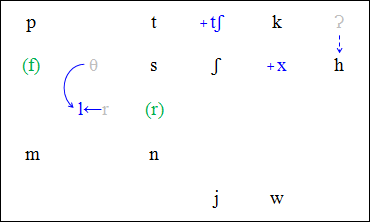
Notes from Goddard 1982:
- /p, t, tʃ, k, s, ʃ/ are voiced after a homorganic nasal.
- /s/ was formerly [θ] for many speakers.
- /x/ arose in certain clusters; phonetically, it is [x̣] with strong friction.
- /l/ was PEA *r and was written "r" in 1670s documents; it is voiceless with lateral friction word-finally, before stops or affricates, and after /h/.
- /w, j/ are usually partly devoiced word-medially before voiceless consonants except /x, h/.
- *ʔ was only in clusters; it mostly fell together with *h (see PEA and Delaware clusters for details).
- Modern Munsee allows /f/ and retroflex /r/ in otherwise assimilated loanwords.
Nanticoke

Notes from Pentland 1979:
- Split: *t > /t/, /ts/
- Merger in Nanticoke A: *θ, *r > /l/
- Merger in Nanticoke B: Nanticoke B: *θ, *r > /j/
- Exception: In inflectional endings, *r > /s/ (Pentland 1979)
- *ʔ (only found in clusters) > /h/
- Split-merger: *ʃ > /ts/ initially, /s/ elsewhere
Plains languages
Cheyenne
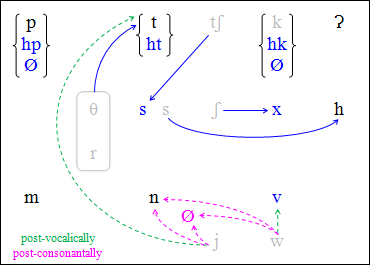
Notes from Goddard 1988:
- These are the underlying reflexes.
- Plosives: *p > word-initial /p/ (optionally lost) and word-medial /hp/ (optionally lost). *t > word-initial /t/ and word-medial /ht/. *k is lost word-initially and becomes /hk/ word-medially (optionally lost).
- Fricatives: *θ, r > /t/, *s, h > /h/, *ʃ > /x/ (and *[tʃ] > /s/).
- Glides: Post-vocalically, *j > /t/ and *w > /v/ (via [β], Picard 1984: 114). Post-consonantallly, *w merges with *j to become Pre-Cheyenne *j, which usually deletes, but if the preceding consonant is PA *p or *k and is lost, Pre-Cheyenne *j > /n/.
- Pre-Cheyenne *j has two sources: (1) PA *j or *w, (2) insertion of /j/ between PA *k__*e(ː) ("yodation"). Presumably PA *j fell together with *θ and *r to something that was neither /j/ nor /t/, which then took part in yodation before shifting to Cheyenne /t/ (if not lost or > /n/).
- Final syllables are lost if they began with *p, k, s, h, m, n, w whose Cheyenne reflex would have followed a vowel, or if the syllable would have begun with Cheyenne /h/ reflecting a cluster.
- Phonetics: /hC/ is [hC], except /eht/ is [est] and /ehk/ is [eʃk]. /x/ is [ʃ] when the only flanking vowel, or both flanking vowels, are /e, é/, and [s] before /ó/. /te/ is pronounced [tse].
Proto-Arapaho-Gros Ventre
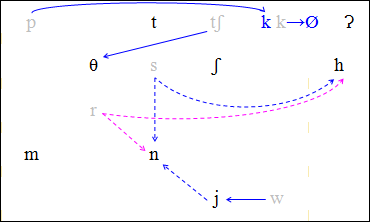
Resulting inventory and clusters (Goddard 1974):

Notes from Goddard 1974:
- *k is lost everywhere without a trace; subsequently, *p becomes *k (part of a larger delabialization affecting *p, *w, *u).
- *θ > *ʃ in clusters only; later, *tʃ > *θ everywhere.
- *s and *r both split-merge with *n and *h, but the conditioning is different. *s > *n initially and *h elsewhere; *r > *n initially and post-vocalically and *h elsewhere (i.e. post-consonantally).
- *w falls together with *j everywhere; the result becomes *j after a consonant and *n initially or after a vowel.
- *h as a single consonant remains unchanged (but lost in clusters).
- *ʔ occurred only clusters, and is found in the reflexes of *ʔC and *NC clusters in PAGV (sometimes as a single consonant after the loss of *k).
Arapaho

Notes from Goddard 1974:
- PAGV *CV̆N > /C/; PAGV *CV̆# > /CV̆ʔ/.
- *k, ʃ, m shifted depending on the backness of neighbouring vowels.
- *k fronted to /tʃ/ before PAGV *e(ː), *i(ː), *j and word-finally after PAGV *e(ː), *i(ː). [However, this change did NOT take place between ɔ(ː)__e(ː), where back /k/ remained.]
- *k remained back /k/ elsewhere.
- *ʃ fronted to /s/ before PAGV *e(ː), *i(ː), *j and word-finally after PAGV *e(ː), *i(ː). [However, this change did NOT take place between ɔ(ː)__e(ː), where backing to /x/ occured.]
- *ʃ backed to /x/ before PAGV *ɔ(ː) and Arapaho ɯ(ː), between ɔ(ː)__e(ː), and word-finally after *ɔ(ː), ɯ(ː).
- *m backed (?) to /w/ before PAGV *ɔ(ː) and Arapaho ɯ(ː) and word-finally after *ɔ(ː), ɯ(ː). [But NOT between ɔ(ː)__e(ː), which did condition the back reflexes of *k and *ʃ.]
- *m > /b/ elsewhere: before PAGV *e(ː), *i(ː), *j and word-finally after PAGV *e(ː), *i(ː). [Including between ɔ(ː)__e(ː), which was associated with back reflexes for *k and *ʃ.]
- More recently, *nj > /j/, other *Cj > /C/, and *h > Ø / __#.
- From Goddard's 1995 review of Picard 1994: The consonantal shifts had mirror-image conditioning: k > tʃ in fronting environments, ʃ > x in complementary backing environments, and *m > w in a smaller set of backing environments (which excludes *o__*e). Later, remaining ʃ > s and m > β > b.
Gros Ventre
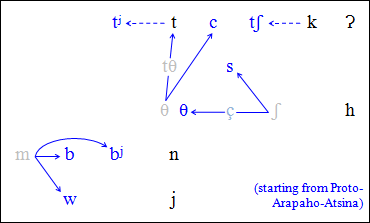
Notes from Goddard 1974:
- *ʃj, *θj > *ʃ, *θ (followed by the regular developments for these protophonemes).
- PAGV *CV̆N > /C/.
- *t, k, ʃ, m shifted depending on the height and backness of neighbouring vowels. Word-final position counts as a "high" environment (which Goddard says is "unexpected").
- *t raised to /tʲ/ before PAGV *i(ː), *j, and word-finally. Elsewhere it remained /t/.
- *k fronted to /tʃ/ before *e(ː) and remained /k/ elsewhere.
- *θ became the affricate /tθ/ before a low vowel (*e, eː, ɔ, ɔː), which merged with /t/ in recent times.
- *θ became palatal /c/ before a high vowel (*iː, i, j) and word-finally.
- *ʃ became palatal /ç/ before a low vowel (*e, eː, ɔ, ɔː), which became a new phoneme /θ/ in recent times.
- *ʃ became /s/ before a high vowel (*iː, i, j) and word-finally.
- *m became /w/ before back *ɔ, ɔː, /b/ before low front *e, eː, and /bʲ/ before high front *i, iː, j and word-finally.
- In recent times, *nj > /j/ and other *Cj > /C/ (which does not affect /tʲ/ and /bʲ/ from *t and *m).
Nawathinehena

Notes from Pentland 1979:
- *ʔ occurred only in clusters; in Nawathinehena it is retained there, but also occurs on its own (*ʔk > /ʔ/).
- *k > Ø, *p > k
- *t, *s > /ht/
- *θ, *r > /t/
- Split: *t > /ht/, /htʃ/
- Phonetic change: *ʃ > /s/ (though Pentland says it may be [ʃ] or [x])
- Semivowels: in most environments, *j and *w fell together, becoming /n/, /i/, or coalescing with a vowel. Initial *w > /w/ or /m/ depending on the word.
Blackfoot

Notes from Berman 2006 (unless another source is specified):
- These should be considered to be the basic, underlying reflexes only.
- I am using /x/ for Berman's /h/, which is phonetically [x] (Frantz 1991: 4).
- Initial *t > /k/; initial *θ (?), *r, *ʃ, *tʃ > /s/; medial *θ, *r, *ʃ, *tʃ > /t/; intervocalic *s > /xs/.
- Blackfoot /t/ (from any source) becomes /ts/ before /i(ː)/ (from any source) and becomes [st] after PA *i, *iː, *#e. Blackfoot /k/ becomes /ks/ before *i(ː).
- /ts/ and /ks/ are considered to be phonemes (Denzer-King 2012: 99).
- Blackfoot /k, x/ → [c, ç] after /i(ː)/.
- The first element of clusters becomes /x/; all Blackfoot /x/ are found in the environment VxC.
- The reflex of *h in clusters is /x/; Berman does not address the reflex of single PA *h, but it has not been retained as /x/.
- Blackfoot also has the phoneme /ʔ/ (Frantz 1991: 5). It cannot be from PA *ʔ, which occurred only as the first element of clusters (> /x/). Berman does not discuss this. What is the source of Blackfoot /ʔ/?
- All consonants can be phonemically long or short, except /ʔ, x/ (Frantz 1991: 5). The geminates are thought to have arisen historically from syncope (Thomson 1978); geminate /ss/ also occurs as the first element in a cluster (instead of usual /x/) after *i(ː) and initial *e.
- Denzer-King (2012) proposes that Blackfoot /s/ is inherently moraic, based on its unique distribution.
- For discussion of semivowel reflexes, see the vowel chart.